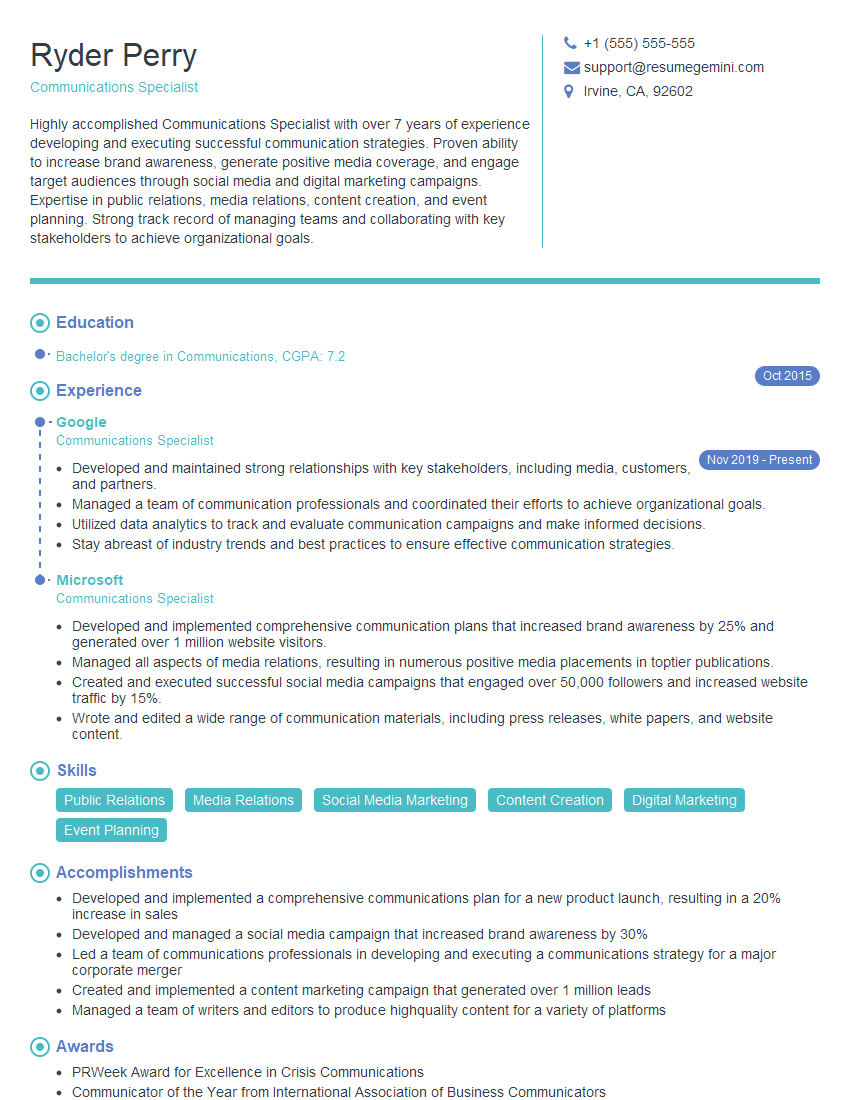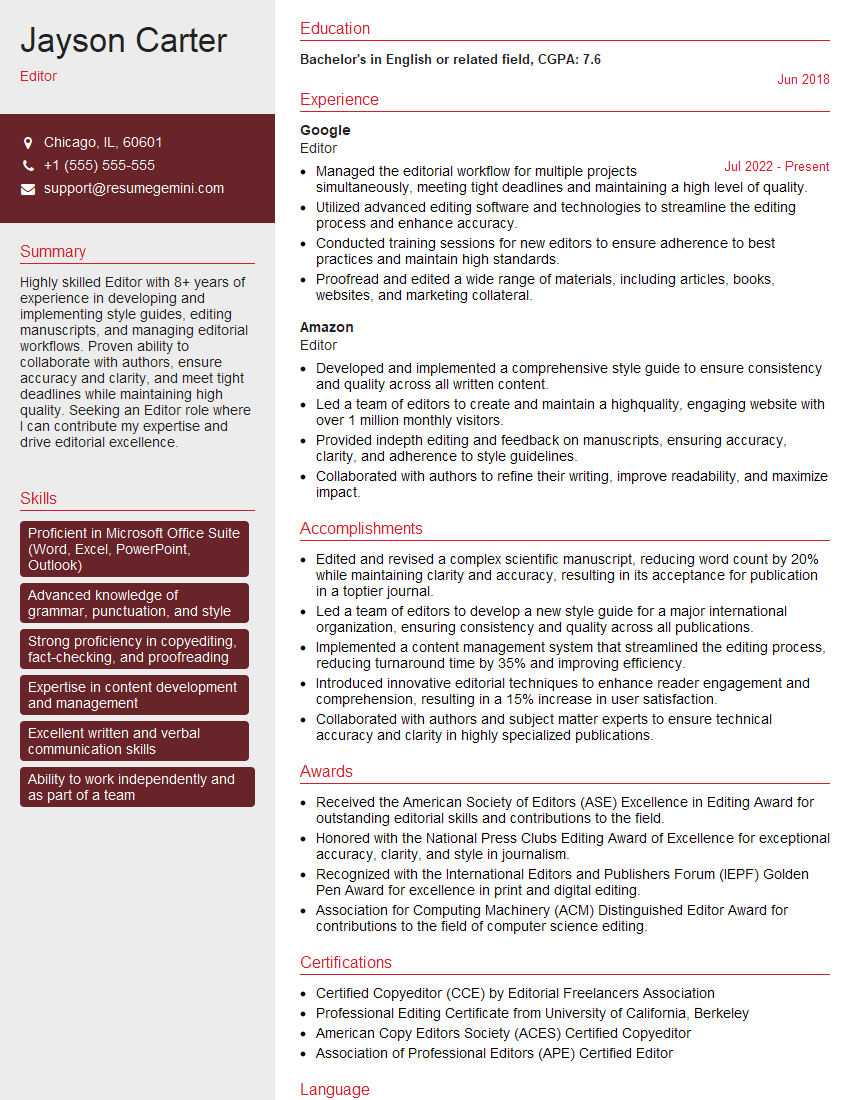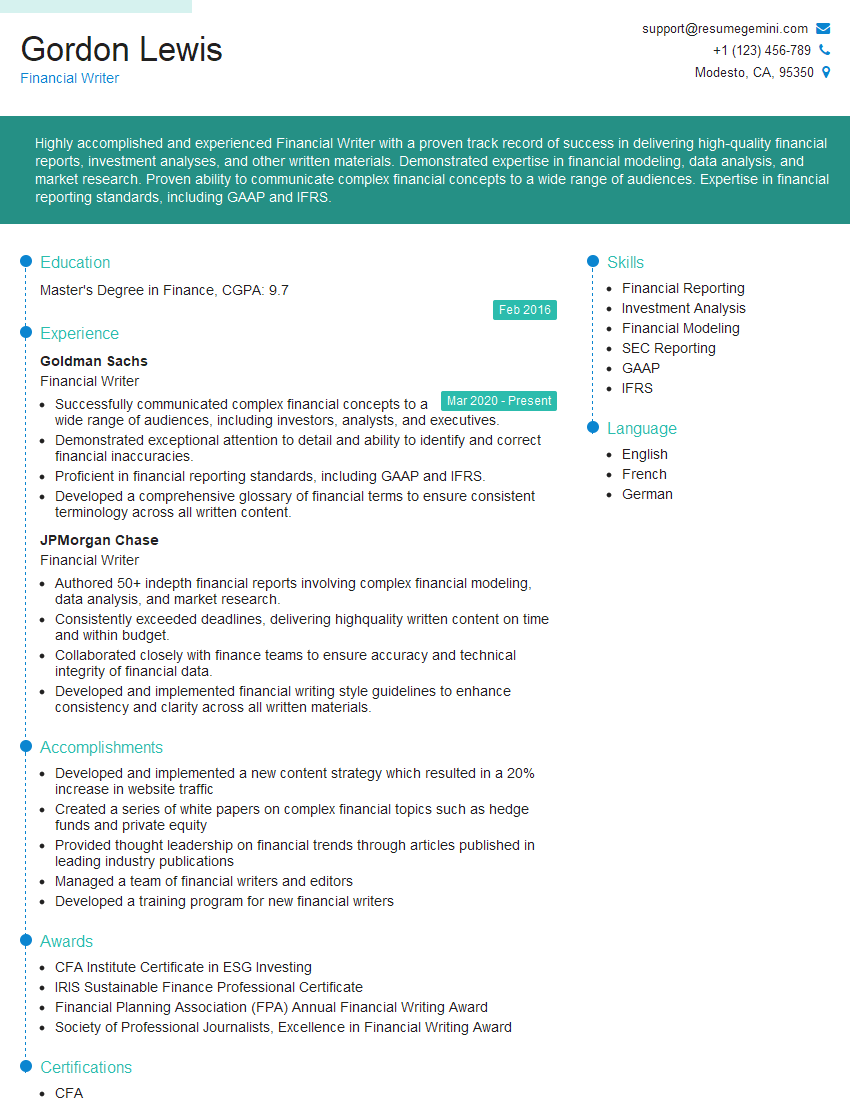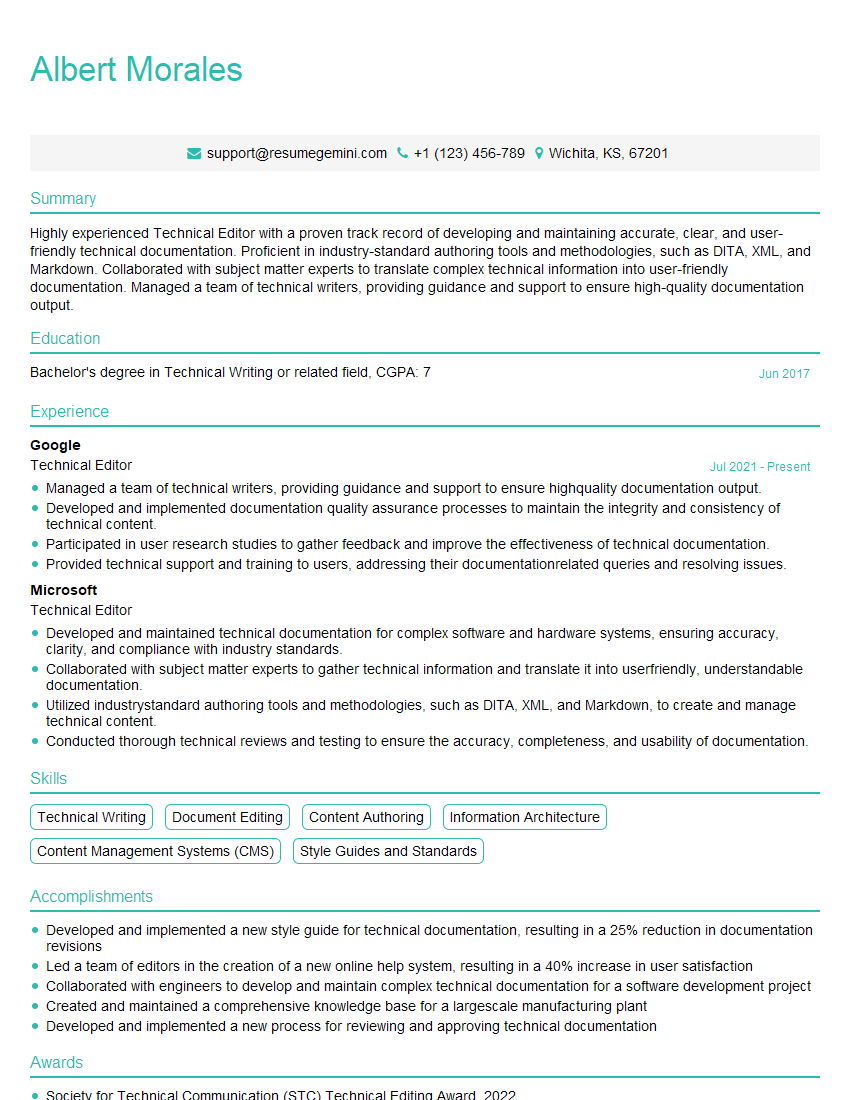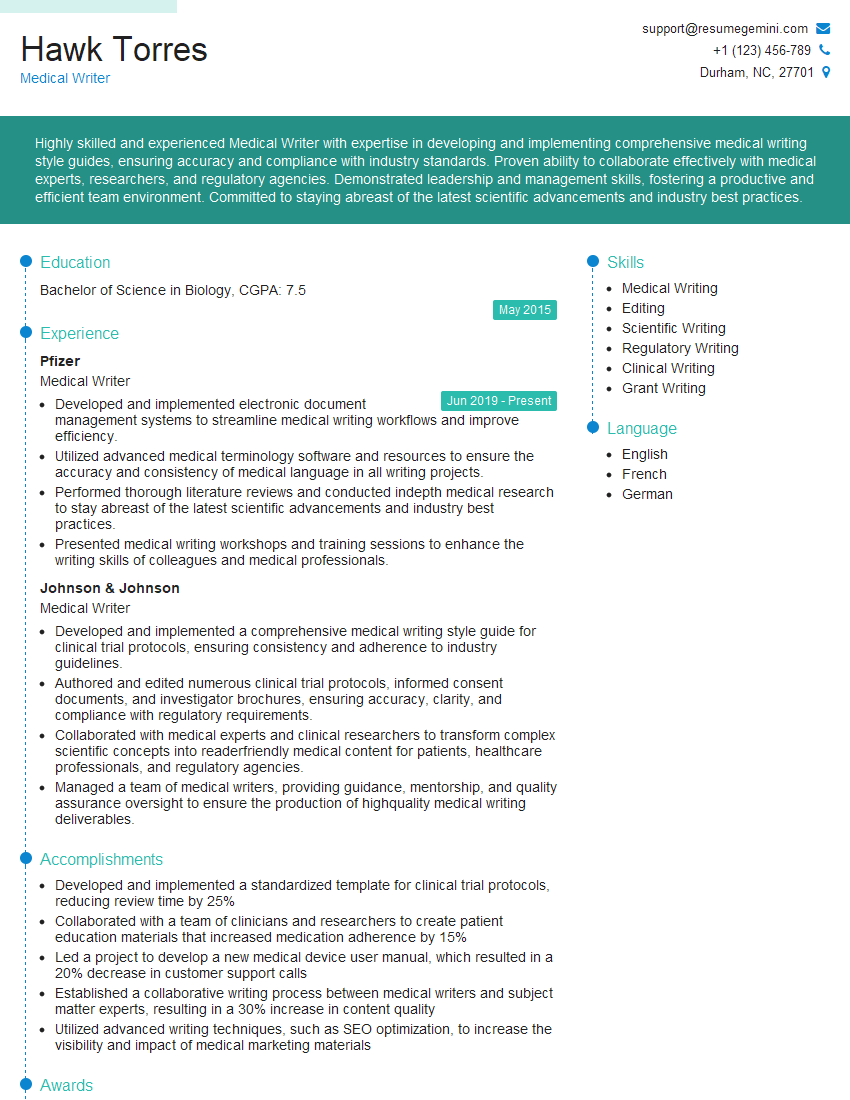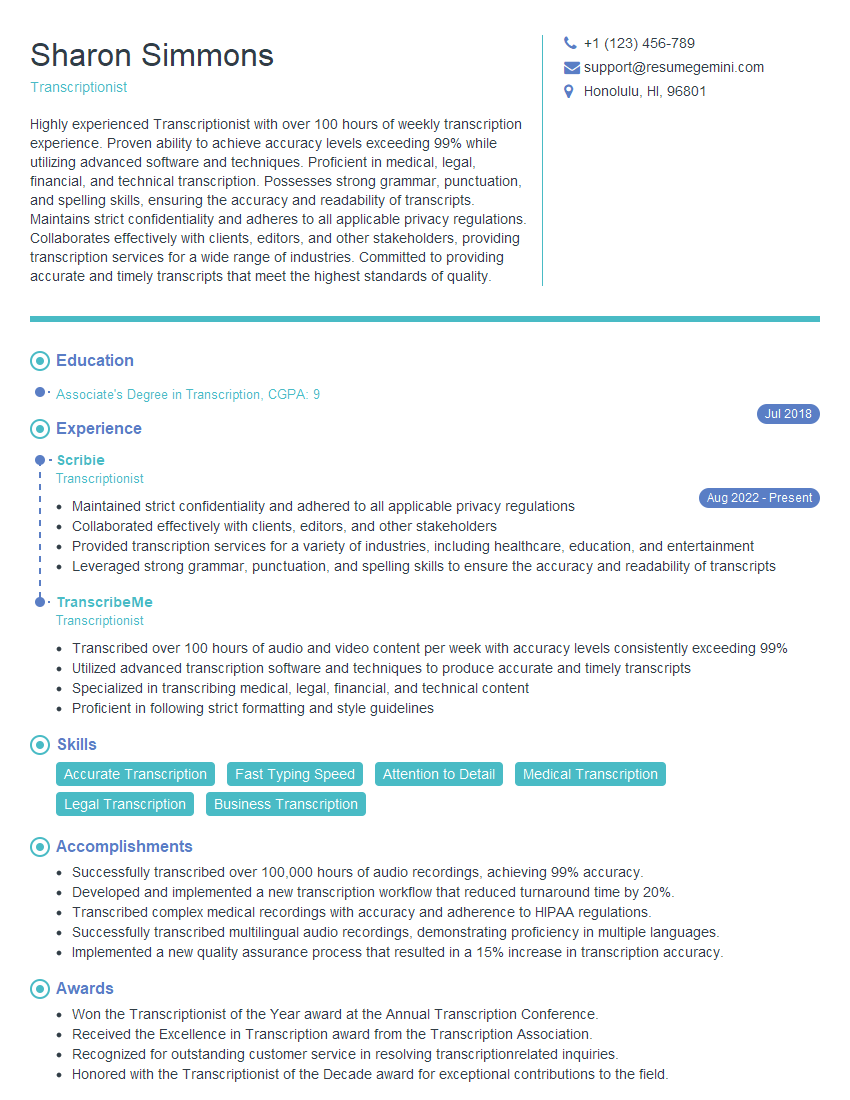Interviews are opportunities to demonstrate your expertise, and this guide is here to help you shine. Explore the essential Ability to identify and resolve language inconsistencies interview questions that employers frequently ask, paired with strategies for crafting responses that set you apart from the competition.
Questions Asked in Ability to identify and resolve language inconsistencies Interview
Q 1. What are the most common types of language inconsistencies you encounter?
The most common language inconsistencies I encounter fall into several categories: grammatical errors (subject-verb disagreement, incorrect tense, punctuation flaws), stylistic inconsistencies (variations in tone, sentence structure, and vocabulary), terminological discrepancies (using different terms to refer to the same concept), and inconsistencies in formatting (e.g., inconsistent use of capitalization, numbers, or dates). Imagine reading a report where sometimes ‘clients’ are called ‘customers’, and the writing shifts from formal to informal unexpectedly – that highlights multiple types of inconsistency.
- Grammatical errors: These are straightforward violations of grammatical rules, hindering clarity and professionalism.
- Stylistic inconsistencies: These impact readability and the overall feel of the document. A shift in tone (e.g., from serious to humorous) can be jarring.
- Terminological discrepancies: These create confusion, making it difficult for the reader to follow the central ideas.
- Formatting inconsistencies: These distract readers from the content and undermine professionalism.
Q 2. Explain the difference between grammatical errors and stylistic inconsistencies.
While both grammatical errors and stylistic inconsistencies affect the quality of writing, they address different aspects. Grammatical errors are violations of the rules of grammar – they’re objectively wrong. Think of it like breaking a traffic law; it’s clearly incorrect. Stylistic inconsistencies, on the other hand, involve deviations from a consistent style guide or an established pattern within a document. It’s more like choosing the wrong outfit for a formal event – not technically incorrect, but inappropriate for the context.
For example, a grammatical error would be writing “He go to the store.” A stylistic inconsistency would be alternating between using active and passive voice without a clear reason, causing a jarring effect.
Q 3. Describe your process for identifying and correcting inconsistencies in tone and style.
My process for identifying and correcting tone and style inconsistencies begins with a thorough first read-through, focusing solely on the overall flow and voice. I look for jarring shifts in formality, word choice, and sentence structure. I then create a style guide based on the most frequently used patterns, aiming for a consistent voice. I use this guide to make targeted edits in a subsequent pass, ensuring consistency throughout.
Tools like Grammarly can help identify some stylistic issues, but often manual review is essential. For example, if a document shifts from a formal, academic tone to a conversational one, I might adjust word choices (replace ‘utilize’ with ‘use’), sentence structure (break up long complex sentences), and overall formality (avoid jargon where appropriate).
Q 4. How do you handle conflicting terminology within a document?
Conflicting terminology is a common issue. My approach involves creating a glossary of terms, listing each term alongside its preferred equivalent. This ensures consistency. If the context necessitates using alternative terms, I add a footnote or in-text explanation the first time it appears, to avoid confusion. In a technical document, this is especially important.
For example, if a document uses both “customer” and “client,” I decide on a preferred term (say, “customer”) and replace all instances of “client” with “customer.” If necessary, I add a brief note explaining the equivalence to ensure readers understand.
Q 5. How do you ensure consistency in language across multiple documents or projects?
Ensuring consistency across multiple documents or projects requires a proactive approach. I start by establishing a style guide tailored to the project’s needs. This guide serves as a central reference point for all writers and editors involved. Using shared collaborative platforms and style guides allows for better tracking and enforcement of consistency. Version control systems, and regular review sessions help ensure the consistency of style, voice, and terminology remains consistent throughout the project lifecycle.
Imagine a series of marketing materials. A consistent style guide would ensure the brand voice remains uniform across brochures, website content, and social media posts.
Q 6. Describe a time you had to resolve a complex language inconsistency. What was your approach?
I once worked on a large technical manual where different sections were written by various engineers, each with their preferred style. The resulting document had jarring shifts in tone, terminology, and overall style. My approach involved first creating a comprehensive style guide based on the existing best practices within the text. I then conducted a thorough review, identifying and categorizing all inconsistencies. I prioritized correcting the most significant inconsistencies first, such as conflicting terminology and major tone shifts. Finally, I collaborated with the engineers, explaining my rationale and working towards consensus on terminology and style preferences.
Q 7. What tools or technologies do you use to identify and resolve language inconsistencies?
I utilize several tools to enhance my efficiency and accuracy. Grammarly is invaluable for identifying grammatical errors and some stylistic issues. Microsoft Word’s built-in features, particularly its style checker and find/replace functionality, are helpful for consistent formatting and term replacement. For large projects, dedicated style guides and terminology databases enhance consistency. For collaborative projects, cloud-based platforms and version control systems play a vital role.
Q 8. How do you prioritize different types of language inconsistencies when editing?
Prioritizing language inconsistencies is crucial for efficient editing. I approach this systematically, focusing first on inconsistencies that significantly impact clarity and meaning. This includes things like contradictory statements, factual errors, and shifts in tense or person that disrupt the flow and understanding of the text. For instance, referring to a character as ‘he’ in one paragraph and ‘she’ in another is a critical error requiring immediate attention. After addressing these major inconsistencies, I move to stylistic inconsistencies that, while not as impactful on meaning, still detract from the overall quality and professionalism. This could include inconsistent use of capitalization, punctuation, or abbreviation. I often use a tiered approach, marking these with different levels of severity in my editing software to manage the workflow.
Think of it like fixing a house – you wouldn’t paint the walls before shoring up a collapsing foundation. Similarly, addressing major meaning-altering inconsistencies takes priority over minor stylistic issues.
Q 9. How do you deal with inconsistencies in formatting and style?
Inconsistencies in formatting and style are addressed by establishing a clear style guide, either a pre-existing one provided by the client or one I create based on the text’s context and target audience. I use a combination of manual review and tools like automated style checkers. The style guide acts as the ultimate authority. For example, if the guide specifies using the Oxford comma, I will consistently apply it throughout the text. If inconsistencies are already present, I create a detailed list of discrepancies, highlighting examples and suggesting a unified style. I would then present this list to the author for approval before making widespread changes. This collaborative approach minimizes conflicts and ensures the author is happy with the final formatting choices.
For instance, if the document mixes italics and bold for emphasis, I’d choose one consistent method according to the style guide and change the rest accordingly. Consistent use of heading levels and font sizes also falls under this category. Tools can help identify inconsistencies, but manual review is always needed to catch nuanced problems.
Q 10. What is your experience with style guides and how do you use them?
I have extensive experience with various style guides, including Chicago, APA, MLA, and company-specific guides. My approach involves thoroughly reviewing the chosen style guide before beginning the editing process. I usually create a handy checklist based on the most common style points to ensure consistency. This checklist might include aspects such as number formatting, citation style, heading levels, and punctuation rules. During editing, I cross-reference the text against the checklist and use the guide to resolve any ambiguities or conflicts. This methodical approach minimizes errors and ensures adherence to the specified style. I also use style guide resources online to confirm my understanding when dealing with less familiar style guidelines.
For example, when editing academic papers, I meticulously follow APA guidelines for citations and formatting. Understanding the nuances of these guides is critical, especially regarding in-text citations and reference page formatting.
Q 11. How do you handle ambiguous language or unclear phrasing?
Ambiguous language and unclear phrasing are addressed through careful analysis and collaborative discussion. My first step is to identify the source of the ambiguity. Is it vague vocabulary? Poor sentence structure? Lack of context? Once the problem is pinpointed, I consider possible solutions. Sometimes, a simple word choice change can resolve the issue. Other times, restructuring the sentence or paragraph is necessary to provide more context. If the ambiguity is too significant and I’m unsure about the author’s intent, I directly communicate this with the author for clarification.
For example, a sentence like ‘The project was delayed due to unforeseen circumstances’ is ambiguous. I might suggest rewriting it as ‘The project was delayed due to the unexpected equipment failure,’ making the reason explicit. Communication with the author to ensure we are both on the same page is always my preference to maintain the original meaning.
Q 12. How do you ensure that your edits maintain the original meaning and intent of the text?
Maintaining the original meaning and intent is paramount. My editing process involves a careful balance between improving clarity and preserving the author’s voice. I always strive to understand the author’s overall message and tone before making any changes. I use annotation tools to explain the rationale behind my edits, so authors can understand the logic and purpose. Whenever making changes that might alter the meaning, even slightly, I discuss them with the author first. I believe editing shouldn’t be a rewrite; it should refine and enhance the original work.
For example, if an author uses a colloquialism that is inappropriate for the target audience, instead of removing it entirely, I might suggest a more formal synonym that keeps the original tone while achieving a more professional style.
Q 13. Describe your approach to working with writers who have different writing styles.
Working with writers having different styles requires adaptability and a focus on maintaining a consistent tone across the whole document, not necessarily on uniform style. My approach involves understanding each writer’s strengths and weaknesses, and using my editing skills to bridge any stylistic gaps. I won’t try to force a uniform style upon every writer; instead, I’ll highlight inconsistencies, suggesting options for unifying the document’s flow without sacrificing the individual author’s voice where possible. The focus is always on clear and effective communication, rather than absolute stylistic homogeneity. My aim is to guide different writing styles to a unified and coherent whole.
For example, one writer may be very concise, while another is more verbose. Instead of forcing both to adopt one style, I might suggest shortening lengthy sentences in the verbose text and expanding concise sections where clarity requires it. The goal is a balanced, consistent final product.
Q 14. How do you communicate your editing changes to authors effectively?
Effective communication of editing changes is crucial. I use a track-changes feature in word processing software to show every alteration made to the text. Moreover, I provide detailed comments explaining the reasons for each change. My comments avoid criticism and focus on improving clarity, style, and consistency. I include links to the style guide to help the author understand the rationale. For larger edits or complex issues, I schedule a meeting or email exchange to discuss my changes with the author. I always welcome feedback and further discussions. Open and clear communication is paramount for a successful editing experience.
Think of it like providing constructive feedback; clarity and respect go a long way in ensuring the author is receptive to the changes.
Q 15. How do you manage multiple language versions of a document?
Managing multiple language versions of a document efficiently requires a structured approach. I typically employ a Translation Management System (TMS) or a collaborative platform like Google Workspace or Microsoft 365. These tools allow for version control, streamlined workflows, and easy access for translators and reviewers.
For example, I might create a master document in the source language and then create separate, linked files for each target language. This ensures consistency and allows translators to work simultaneously without overwriting each other’s changes. The TMS or platform’s version history feature is invaluable for tracking changes and reverting to previous versions if needed. Furthermore, I utilize a consistent file naming convention (e.g., ‘document_en.docx’, ‘document_es.docx’) to maintain organization.
Beyond technology, clear communication with translators is vital. Providing a style guide, glossary of terms, and any relevant cultural context are key to ensuring consistency across all language versions. Regular check-ins and feedback sessions help address any questions or challenges that might arise.
Career Expert Tips:
- Ace those interviews! Prepare effectively by reviewing the Top 50 Most Common Interview Questions on ResumeGemini.
- Navigate your job search with confidence! Explore a wide range of Career Tips on ResumeGemini. Learn about common challenges and recommendations to overcome them.
- Craft the perfect resume! Master the Art of Resume Writing with ResumeGemini’s guide. Showcase your unique qualifications and achievements effectively.
- Don’t miss out on holiday savings! Build your dream resume with ResumeGemini’s ATS optimized templates.
Q 16. What are your strategies for proofreading and ensuring accuracy?
My proofreading strategy is multi-layered and combines automated tools with meticulous manual checks. I start with a spell and grammar check using software tailored to each language. This catches obvious errors, but it’s only the first step.
Next, I perform a thorough manual review, focusing on style, consistency, and accuracy of translation. I pay close attention to nuances in meaning and ensure the tone and register align with the original document. This often involves comparing the translated text against the source text line by line.
For particularly critical documents, I employ a second proofreader. A fresh pair of eyes can often spot errors that I’ve missed, especially regarding subtle inconsistencies or language-specific issues. Think of it like baking – even a great recipe can benefit from a second opinion before it goes into the oven!
Q 17. How do you identify and address inconsistencies in terminology across different languages?
Identifying and addressing terminology inconsistencies is crucial for maintaining a professional and credible image. I begin by creating or utilizing a terminology database or glossary. This database becomes a central repository for approved translations of key terms, ensuring consistency across all languages.
For example, if a document refers to ‘customer success manager’ in English, I’ll ensure the same consistent translation is used throughout all target languages, even if slight variations exist in the target language’s common phrasing. I also use Computer-Assisted Translation (CAT) tools that incorporate these glossaries and leverage translation memory to suggest consistent translations throughout the document.
When inconsistencies inevitably arise, I discuss them with the client or translation team. We then decide on the most accurate and appropriate terminology based on the specific context and target audience. Any updates are immediately added to the glossary to avoid future discrepancies.
Q 18. How familiar are you with different language varieties (dialects, registers)?
My familiarity with language varieties (dialects and registers) is extensive. I understand that a single language can manifest in vastly different ways depending on geographic location, social context, and audience.
For instance, I’m aware of the subtle differences between American and British English, or the variations in Spanish spoken in Spain versus Mexico. Similarly, I understand the importance of adapting language to the appropriate register – whether it’s formal, informal, technical, or literary. This knowledge helps me choose the most appropriate language variant and style for the intended audience and purpose of the document.
In practice, this awareness means I don’t simply translate word-for-word. Instead, I adapt the language to fit the cultural and stylistic norms of the target audience. Using the wrong register could lead to miscommunication, and using an inappropriate dialect might alienate the target audience.
Q 19. How do you manage your time effectively when dealing with multiple language inconsistencies?
Managing my time efficiently when dealing with multiple language inconsistencies involves a combination of careful planning and prioritization. I begin by breaking down the task into smaller, manageable chunks.
This might involve tackling one language version at a time, or focusing on specific sections of the document that are most prone to inconsistencies. I set realistic deadlines for each segment of work and utilize time-tracking tools to monitor my progress and identify potential bottlenecks.
Proactive communication with stakeholders is also key. By anticipating potential problems and seeking clarification early on, I can prevent delays and avoid having to rework sections later. This approach mirrors the efficiency of an agile development process – small, iterative steps lead to better time management and a higher quality product.
Q 20. What is your preferred method for tracking changes and revisions?
My preferred method for tracking changes and revisions is through version control systems integrated into my chosen TMS or collaborative platform. These systems automatically track changes and allow me to revert to earlier versions if needed.
For more complex projects, I also use a dedicated change tracking feature within word processing software (like Track Changes in Microsoft Word or similar features in Google Docs). This allows for detailed logging of edits made by myself and other reviewers, improving transparency and collaboration.
In addition, I maintain detailed notes documenting my decisions and the reasoning behind them – this is particularly valuable when addressing complex inconsistencies or stylistic choices. This meticulous record-keeping makes it easier for others to understand the editing process and facilitates future revisions.
Q 21. How do you handle feedback and criticism on your editing work?
I value feedback and criticism as essential components of improving my work. I approach feedback constructively, seeing it as an opportunity to learn and refine my skills.
My response to feedback involves carefully considering the points raised, asking clarifying questions if needed, and understanding the rationale behind the criticism. I then assess whether the feedback is valid and reflects potential improvements in my process or final product.
Even if I disagree with a specific suggestion, I try to understand the underlying concern. This allows for a professional dialogue leading to better solutions. Ultimately, my goal is to deliver high-quality work, and feedback is an integral part of achieving that goal. I embrace it as a chance for continuous growth and enhancement of my ability to identify and resolve language inconsistencies.
Q 22. How do you stay up-to-date with changes in language usage and style?
Staying current with language evolution is crucial for any editor. I employ a multi-pronged approach. Firstly, I regularly read reputable style guides like the Chicago Manual of Style and AP Stylebook, paying close attention to updates and revisions. These guides are the bedrock of consistent and accurate language use. Secondly, I subscribe to linguistics journals and publications that track changes in language use, slang, and evolving grammar rules. This proactive approach helps me anticipate shifts in acceptable usage. Finally, I actively participate in online communities and forums for editors and writers, engaging in discussions and learning from the experiences of my peers. This allows me to pick up on emerging trends and best practices directly from the field.
Q 23. How do you adapt your editing approach to different types of content (e.g., technical, marketing, creative)?
Adapting my editing style to various content types is paramount. Technical writing, for instance, requires precision and clarity, often employing specialized terminology. My approach here involves thorough research to understand the subject matter and ensure accuracy of technical terms. In contrast, marketing materials prioritize engaging language, persuasive tone, and a focus on the target audience. This necessitates a shift towards a more dynamic and emotive style. Creative writing, on the other hand, allows for greater stylistic freedom, emphasizing narrative flow and evocative language. The key is to understand the unique goals and audience of each content type and adjust my editing accordingly. I always aim for clarity and accuracy, but my approach to achieving this varies based on the context.
Q 24. How do you ensure consistency in voice and tone across a body of work?
Maintaining consistent voice and tone across a body of work is crucial for brand identity and reader experience. I begin by collaborating with the client or team to define the desired voice and tone—is it formal or informal? Friendly or authoritative? Humorous or serious? Once established, I create a style guide—a living document—outlining preferred terminology, sentence structure, and tone. I use this guide as a reference point throughout the editing process. For large projects, I might employ software tools that automatically flag inconsistencies, such as overly formal or informal word choices. Consistent review and comparison across different sections of the work are also essential to catch any deviations from the established style. This proactive and multi-faceted approach ensures a unified and coherent message.
Q 25. How familiar are you with common grammatical and stylistic errors in English?
I’m very familiar with a wide range of grammatical and stylistic errors in English. This includes common issues like subject-verb agreement, pronoun case errors (e.g., using ‘me’ instead of ‘I’ in a compound subject), comma splices, dangling modifiers, and issues with tense consistency. My knowledge also extends to more nuanced stylistic problems such as passive voice overuse, weak verbs, and wordiness. I consistently apply my understanding of these errors when editing, ensuring clear, concise, and grammatically sound writing. Think of it like a skilled musician – familiarity with the rules of music enables improvisation and creativity without sacrificing fundamental structure.
Q 26. What is your experience with automated language tools and software?
I have extensive experience with automated language tools. I regularly utilize grammar and style checkers such as Grammarly and ProWritingAid. These tools are valuable for catching surface-level errors and inconsistencies. However, I recognize their limitations. I don’t rely on these tools solely; instead, I consider them aids in my workflow. My approach is to use them for initial checks, then conduct a thorough manual review to address nuances and context-specific issues that automated tools may miss. Over-reliance on these tools can lead to unnatural-sounding text. The human touch remains essential for achieving high-quality editing.
Q 27. Describe a situation where you had to resolve a language inconsistency under pressure.
During a crucial marketing campaign launch, a significant language inconsistency emerged across different campaign materials—a key brand slogan was rendered differently in the website copy and the social media posts. This discrepancy risked damaging brand consistency. I immediately prioritized resolving this issue. Working under pressure, I first analyzed the different versions of the slogan, identifying the source of the inconsistency. Then, I collaborated with the marketing team, presenting my findings and proposing a standardized version based on the original brief. This was quickly approved, and the inconsistencies were corrected across all platforms before the campaign’s launch. The situation highlighted the importance of thorough pre-launch checks and proactive communication among team members.
Q 28. How do you handle disagreements with other editors or stakeholders regarding language choices?
Disagreements regarding language choices are inevitable in collaborative editing. My approach centers on professional discussion and finding consensus. I begin by clearly articulating my reasoning for my proposed changes, citing relevant style guides and grammar rules as needed. I avoid becoming entrenched in my own opinion; instead, I actively listen to the perspectives of others. The goal is to reach a solution that is both grammatically sound and consistent with the overall style and purpose of the work. If a compromise cannot be reached, I escalate the issue to a higher authority to reach a final decision, always prioritizing the overall project’s success and the client’s best interests.
Key Topics to Learn for Ability to identify and resolve language inconsistencies Interview
- Understanding Linguistic Nuance: Identifying subtle differences in word choice, tone, and style that can create inconsistencies across different documents or communication channels.
- Grammar and Style Consistency: Mastering grammar rules, punctuation, and style guides (e.g., AP, Chicago) to ensure uniformity in writing.
- Identifying and Correcting Errors: Developing keen proofreading skills to detect grammatical errors, spelling mistakes, typos, and inconsistencies in formatting.
- Maintaining Brand Voice and Tone: Understanding and applying consistent brand voice and tone across all written communications to maintain a unified brand identity.
- Practical Application: Analyzing various types of written content (reports, emails, website copy, etc.) for inconsistencies and applying appropriate corrections.
- Using Style Guides and Dictionaries: Effectively utilizing style guides and dictionaries to resolve language ambiguities and ensure consistency.
- Collaboration and Communication: Effectively communicating identified inconsistencies to colleagues and stakeholders, and collaboratively resolving discrepancies.
- Technology for Consistency: Familiarity with tools and technologies that assist in maintaining language consistency (e.g., grammar checkers, style checkers).
Next Steps
Mastering the ability to identify and resolve language inconsistencies is crucial for success in many professional fields, demonstrating attention to detail, strong communication skills, and the ability to produce high-quality, professional work. A well-crafted resume showcasing these skills is essential for attracting recruiters and landing your dream job. To increase your chances of getting noticed by Applicant Tracking Systems (ATS), focus on building a strong, keyword-rich resume. ResumeGemini can help you create an ATS-friendly resume tailored to highlight your abilities in this area. Examples of resumes tailored to showcase expertise in identifying and resolving language inconsistencies are available through ResumeGemini, helping you present yourself effectively to potential employers.
Explore more articles
Users Rating of Our Blogs
Share Your Experience
We value your feedback! Please rate our content and share your thoughts (optional).
What Readers Say About Our Blog
Hi, I’m Jay, we have a few potential clients that are interested in your services, thought you might be a good fit. I’d love to talk about the details, when do you have time to talk?
Best,
Jay
Founder | CEO
